This project will bring together two promising innovations: a high school course entitled Energizing Physics and the BEAR assessment system. The goal of this study is to develop and test a formative assessment system for Energizing Physics that has the potential to enable all students to learn physics, so they can succeed in college.
Projects
This project develops an instrument to measure the content knowledge that teachers need to teach about energy in high school classroom instruction that focuses on mechanical energy. The project uses a framework that includes tasks based on instructional practices in the classroom that can identify the extent to which the teacher understands both the disciplinary knowledge and the appropriate teaching processes that support student learning.
This project develops an instrument to measure the content knowledge that teachers need to teach about energy in high school classroom instruction that focuses on mechanical energy. The project uses a framework that includes tasks based on instructional practices in the classroom that can identify the extent to which the teacher understands both the disciplinary knowledge and the appropriate teaching processes that support student learning.
This project develops an instrument to measure the content knowledge that teachers need to teach about energy in high school classroom instruction that focuses on mechanical energy. The project uses a framework that includes tasks based on instructional practices in the classroom that can identify the extent to which the teacher understands both the disciplinary knowledge and the appropriate teaching processes that support student learning.
This project develops an instrument to measure the content knowledge that teachers need to teach about energy in high school classroom instruction that focuses on mechanical energy. The project uses a framework that includes tasks based on instructional practices in the classroom that can identify the extent to which the teacher understands both the disciplinary knowledge and the appropriate teaching processes that support student learning.
Through the integration of STEM content and literacy, this project will study the ways teachers implement project practices integrating literacy activities into STEM learning. Teachers will facilitate instruction using scenarios that present students with everyday, STEM-related issues, presented as scenarios, that they read and write about. After reading and engaging with math and science content, students will write a source-based argument in which they state a claim, support the claim with evidence from the texts, and explain the multiple perspectives on the issue.
This project will study the activities of a Networked Improvement Community (NIC) as a vehicle to bridge gaps across four identified steps along the science teacher training and development pathways within local contexts of 8 participating universities. The overarching goal of the project is to strengthen the capacity of universities and school districts to reliably produce teachers of science who are knowledgeable about and can effectively enact the Next Generation Science Standards (NGSS), although prepared in varied organizational contexts.
EarthX is a design-based research project that supports the integration of Earth science into high school biology, chemistry, and physics courses in Baltimore City Public Schools, while also supporting the district’s transition to three-dimensional (3D), ambitious and equitable science teaching aligned with the Next Generation Science Standards (NGSS). EarthX builds on the success of the Integrating Chemistry and Earth Science (ICE) DRK-12 project, which developed innovative chemistry course curriculum materials and PD strategies, to support Earth science integration into biology and physics course curriculum development and 3D teaching. EarthX will develop, test, and refine embedded and unit assessments for all three courses, along with providing an online system for assessment administration; real-time reporting to teachers and students; and provision of data to PD leaders, administrators, and researchers for multiple purposes. Assessments will be 3D, featuring core concepts from both Earth science and the course discipline combined with a science or engineering practice and a crosscutting concept.
This project builds upon the prototype Physics Teaching Web Advisory (Pathway), which was designed to demonstrate the ability to address issues related to the lack of preparation of many physics teachers, and to provide resources that can enliven even the most expert physics teachers' classrooms. Pathway combines state-of-the-art digital video library technology, pedagogical advances and materials contributed by master teachers.
This project augmenting the traditional professional development model with an online professional development platform—the Active Physics Teacher Community—that provides just-in-time support for teachers as they are enacting targeted units of the Active Physics curriculum. Teachers are helped in preparing lessons by providing them with formal instruction related to the lessons they are teaching in the classroom. In addition, teachers can participate in a moderated forum where they can share experiences.
